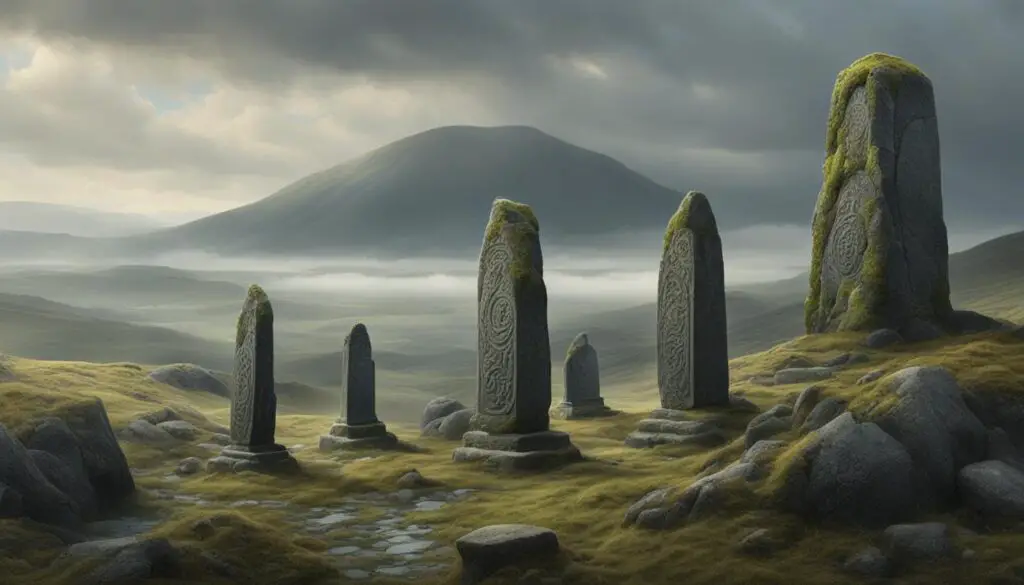Stonehenge, a remarkable prehistoric monument, has intrigued humanity for generations. Its ancient stones hold secrets that link it to the rich tapestry of Celtic mythology, legends, folklore, and religious practices. In this article, we delve into the historical and cultural significance of Stonehenge, exploring its connections to ancient Celtic beliefs, gods, goddesses, rituals, and more.
Key Takeaways:
- Stonehenge holds a deep connection to Celtic mythology, legends, and religious practices.
- Understanding Stonehenge leads to insights into ancient Celtic beliefs, gods, goddesses, and rituals.
- The monument’s enigmatic past continues to captivate researchers, as they uncover the secrets of its construction and purpose.
- Advances in archaeological techniques have shed light on the builders of Stonehenge and the ancient society surrounding it.
- Stonehenge remains an important cultural and historical symbol, embodying the mysteries of our ancient past.
The Building Phases of Stonehenge
Stonehenge, one of the world’s most renowned prehistoric monuments, was constructed in several stages over a span of more than 1,500 years, beginning around 3000 BCE. The construction of Stonehenge involved intricate planning and execution, with each phase contributing to its final form and purpose.
The initial building phase focused on the creation of a circular earthwork enclosure, consisting of a large ditch and bank. This earthwork enclosure served as the foundation for the monument and defined the outer boundary of Stonehenge. It is believed to have been both a symbolic and practical element of the construction process.
During this early stage, the builders also erected a series of smaller circular depressions known as the Aubrey Holes. These holes, named after the antiquarian John Aubrey who first documented them in the 17th century, have long been a subject of speculation and debate. The purpose of the Aubrey Holes remains elusive, with theories ranging from markers for wooden posts to locations for ceremonial offerings.
In the second phase of construction, the iconic sarsen stones were brought to Stonehenge from the Marlborough Downs, located about 20 miles north of the monument. These massive sandstone blocks, some weighing up to 30 tons, were carefully shaped and arranged in a horseshoe shape with a linteled entrance. The precision and engineering ingenuity required to move and position these stones still inspire awe to this day.
In addition to the sarsen stones, smaller bluestones were transported from the Preseli Hills in Wales, over 140 miles away. These bluestones, composed mainly of dolerite and rhyolite, were arranged inside the sarsen horseshoe and are believed to have held deep symbolic significance for the Stonehenge builders.
Together, the sarsen stones and bluestones form the iconic configuration that we see at Stonehenge today. The position and alignment of these stones were integral to the broader design and purpose of the monument, but the exact meaning and function of Stonehenge continue to be the subject of exploration and speculation.
As researchers continue to unravel the mysteries of Stonehenge, each building phase reveals new insights into the cultural and technological achievements of the ancient builders. The construction techniques and the significance of the earthwork enclosure, the Aubrey Holes, and the arrangement of the sarsen and bluestones all contribute to the enigmatic nature of this iconic monument.
The People Behind Stonehenge
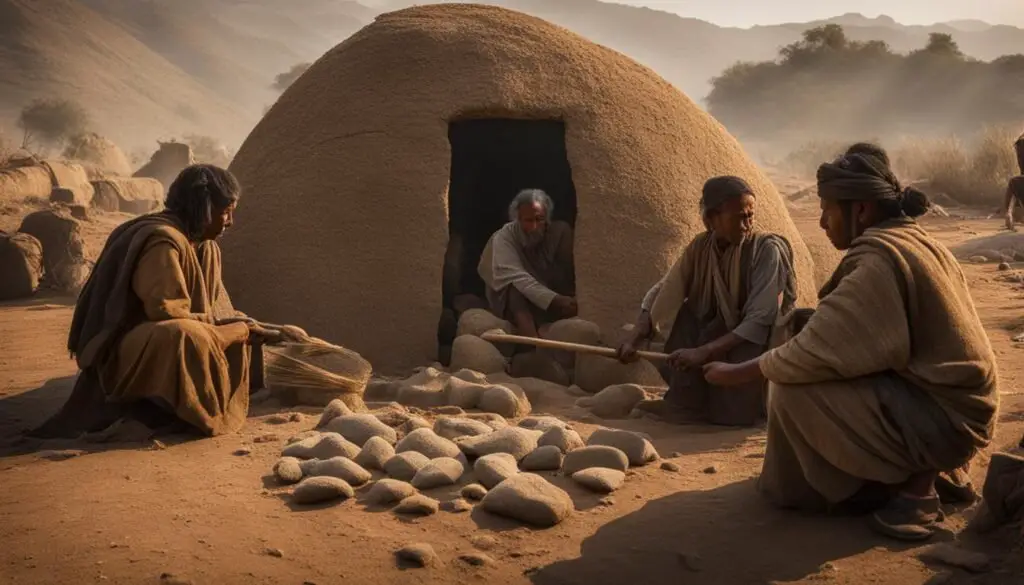
Research has provided some insights into the culture and society of the people who lived in the area during Stonehenge’s construction. Recent discoveries have revealed that these individuals were part of a sophisticated society with advanced knowledge of various crafts. However, it is important to note that Stonehenge predates the arrival of the Celts in Britain.
The Stonehenge Builders: Skilled Craftsmen and Builders
The construction of Stonehenge involved the expertise and labor of highly skilled craftsmen and builders. These individuals were adept at tasks such as quarrying, shaping, transporting, and erecting the massive stones that make up the monument. Their knowledge of engineering, astronomy, and geometry enabled them to create this awe-inspiring structure.
A Window into Stonehenge Culture and Society
Exploring the culture and society of the Stonehenge builders can provide valuable insights into their way of life. The artifacts found in the nearby area, such as pottery, tools, and animal remains, shed light on their daily activities, diet, and trade relationships. Additionally, the burial sites surrounding Stonehenge offer clues about their beliefs and rituals.
The Identity of Stonehenge Builders
While the specific identities of the Stonehenge builders remain unknown, their legacy is etched in the ancient stones that still stand today. The craftsmanship and engineering skills demonstrated in the construction of Stonehenge point to a highly organized and complex society. Unraveling their identity is an ongoing quest for archaeologists and historians.
Astronomical Alignments
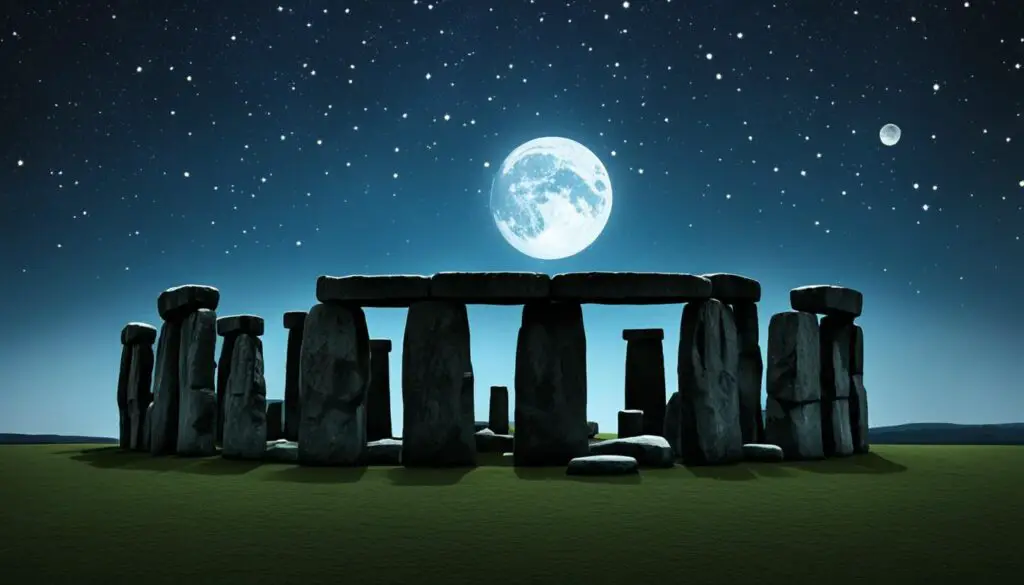
One popular theory about Stonehenge’s purpose is that it served as an astronomical observatory. The monument is aligned with the rising and setting of the sun at the summer and winter solstices, suggesting a connection to tracking the passage of seasons. The Aubrey Holes have been linked to the lunar cycle. However, it is unclear whether astronomy was the primary purpose of Stonehenge or if the alignments served a broader spiritual or ceremonial function.
The Significance of Stonehenge’s Alignments
Stonehenge’s careful alignment with celestial events has long fascinated researchers and sparked numerous theories about its purpose. The monument’s orientation towards the summer solstice sunrise and the winter solstice sunset indicates a keen awareness of the changing seasons and a possible connection to agricultural practices.
Many believe that Stonehenge was used as a celestial calendar, allowing ancient people to anticipate and celebrate the solstices, the longest and shortest days of the year. These important astronomical events may have influenced agricultural activities, religious rituals, and societal schedules.
The Aubrey Holes, named after John Aubrey who first recorded them in the 17th century, are circular pits within the Stonehenge earthwork enclosure. These holes are believed to have held wooden posts, possibly used to track the lunar cycle. The alignment of the Aubrey Holes with the lunar movements suggests a deeper understanding of celestial bodies and their significance in the lives of the people who built Stonehenge.
The precise purpose of these astronomical alignments remains uncertain. While Stonehenge may have functioned as an observatory, providing a platform for observing celestial events, it likely served multiple purposes within the context of ancient rituals and ceremonies.
Stonehenge’s Purpose: A Multifaceted Monument
Stonehenge’s astronomical alignments hint at its potential role as a celestial observatory, but they may also represent a connection to the spiritual and ceremonial beliefs of the people who constructed the monument.
Beyond its astronomical significance, Stonehenge was likely a gathering place for communal rituals and religious ceremonies. The powerful symbolism and imposing nature of the structure would have instilled a sense of awe and reverence among the participants.
The exact rituals and beliefs associated with Stonehenge’s construction and use are still shrouded in mystery. It is possible that the alignments with celestial events were part of a broader belief system that integrated the physical and spiritual dimensions of life.
As the search for answers and new archaeological discoveries continue, Stonehenge’s purpose will likely remain a subject of debate and fascination. The monument’s celestial alignments, coupled with its grandeur and historical significance, make it an enduring symbol of humanity’s quest for understanding the mysteries of the cosmos.
Burial Site and Ancestor Worship
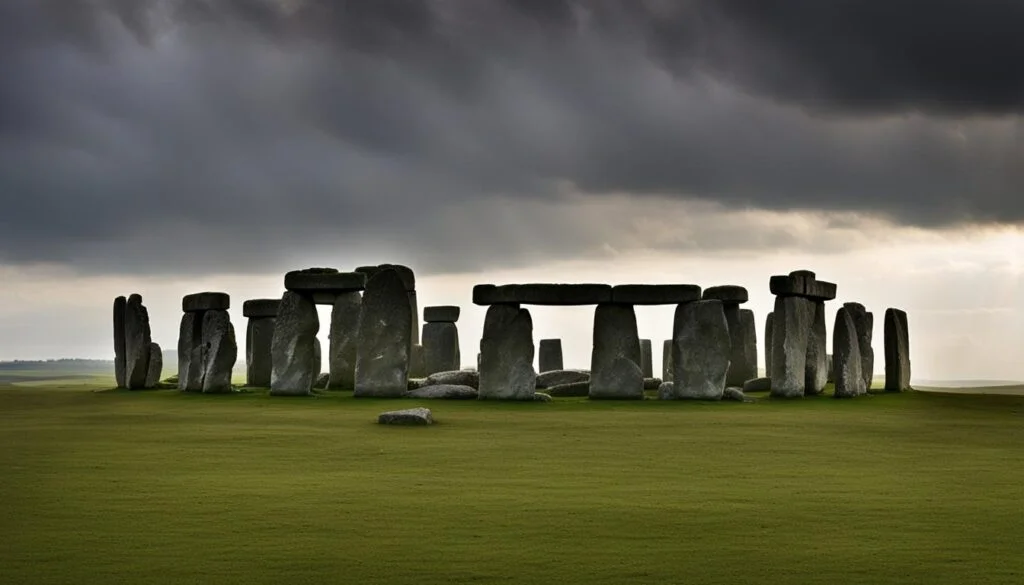
The discovery of human remains at Stonehenge and nearby monuments has led some researchers to believe that the site was used for burial and ancestor worship. Radiocarbon dating has shown that the remains span a period of over 1,000 years, indicating Stonehenge’s use as a burial site throughout its history.
The significance of Stonehenge as a burial site can be attributed to the prominent role that ancestor worship played in ancient societies. Ancestor worship, a form of reverence and respect for one’s forefathers, was a common practice in many cultures around the world. It was believed that by honoring and appeasing the spirits of the deceased, the living could seek their guidance, protection, and blessings.
Stonehenge, with its imposing stone structures and strategic location, may have been perceived as a sacred space where the spirits of ancestors could be venerated. The monument’s position in the landscape, surrounded by earthworks and aligned with celestial events, suggests a connection to the spiritual realm and a place of ritual and ceremony. It is likely that Stonehenge served as a focal point for funerary rites and gatherings, where the living paid their respects to the departed and sought their blessings.
The human remains found at Stonehenge provide valuable insights into the lives and beliefs of the people who built and used the monument. These ancient individuals, whose identities remain unknown, were laid to rest with care and ceremony, emphasizing the importance of proper burial rituals and the connection between the living and the deceased.
The discovery of these human remains adds another layer of complexity to the story of Stonehenge. While the exact nature of ancestor worship and funerary rites practiced at Stonehenge may never be fully understood, the archaeological evidence suggests that this ancient monument held profound spiritual significance for the people of its time.
The Arrival of the Celts

The Celts arrived in Britain around 500 BCE, long after the construction of Stonehenge. While the Celts left their mark on the landscape with their art, language, and religion, they were not the original builders of Stonehenge.
The Celts brought their unique culture and traditions to Britain, significantly influencing the region’s history. Celtic culture was rich in artistic expression, characterized by intricate designs and symbolism. Celtic art, known for its beautiful knotwork and spirals, adorned everything from jewelry to pottery.
Celtic religion was polytheistic, with various gods and goddesses representing different aspects of life and nature. The Celts held sacred rituals and ceremonies, often performed by druids, who were regarded as religious leaders and intellectuals.
The Celtic language, a branch of the Indo-European language family, had its own distinctive characteristics. It was spoken throughout the British Isles and played a vital role in preserving Celtic cultural heritage.
While Stonehenge predates the arrival of the Celts, it is possible that they recognized the monument’s spiritual significance and incorporated it into their own religious practices. However, the exact relationship between Stonehenge and Celtic culture remains a subject of ongoing research and debate.
Connections between Stonehenge and Celtic Culture
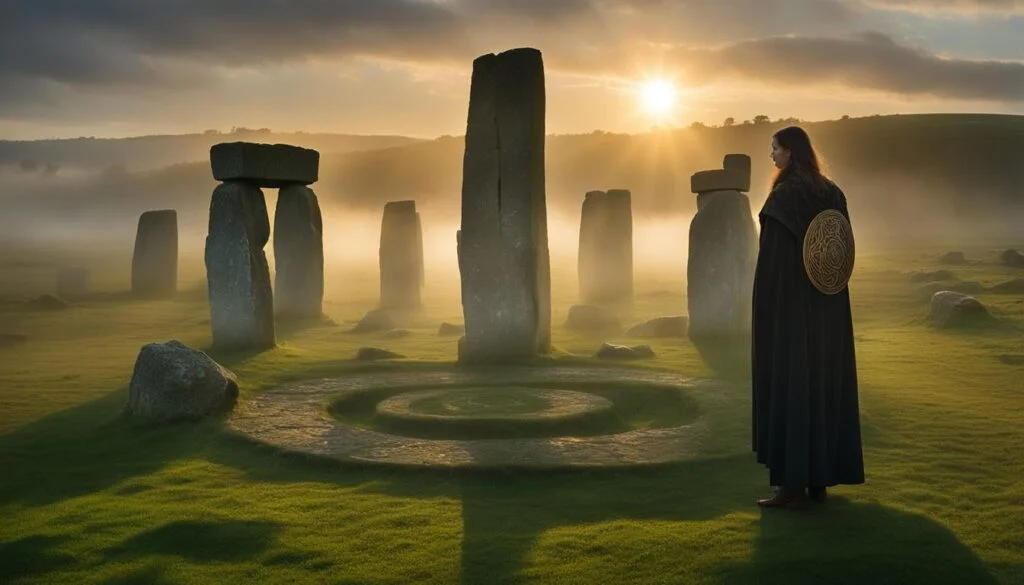
Although the Celts were not responsible for the construction of Stonehenge, their connection to the famous monument runs deep. Evidence suggests that the Celts may have utilized Stonehenge for their own religious and ceremonial practices, incorporating it into their rich mythology and rituals.
The Celts were known for their reverence of sacred spaces, and Stonehenge’s spiritual significance may have been recognized by these ancient people. It is believed that they held religious ceremonies and performed rituals within the stone circle, aligning themselves with the power and energy of the monument.
Stonehenge’s imposing structure and mystical aura may have appealed to the Celts, who held their own set of religious beliefs and customs. The monument’s enigmatic presence would have provided a suitable setting for their rituals, allowing them to connect with the spiritual world and seek guidance from their gods and goddesses.
Celtic mythology is rich with stories of heroic figures, magical creatures, and mythical beasts. Stonehenge may have served as a physical representation of these legends, a place where the boundaries between the mortal realm and the supernatural were believed to be thinner.
While the exact nature of the Celtic rituals performed at Stonehenge may never be fully understood, the connection between the ancient monument and Celtic culture is undeniable. It serves as a testament to the spiritual and cultural significance of Stonehenge, a place where ancient beliefs and traditions converged.
The Influence of Celtic Religion and Mythology
- The Celts believed in a pantheon of gods and goddesses who governed various aspects of life, nature, and the afterlife.
- Celtic rituals often involved offerings and sacrifices to appease the gods and seek their favor.
- Stonehenge’s alignment with celestial events may have been interpreted as a manifestation of divine powers in Celtic mythology.
- The legends and myths of the Celts may have been woven into the rituals performed at Stonehenge, creating a tapestry of spiritual significance.
While the origins and purpose of Stonehenge remain shrouded in mystery, its connection to Celtic culture adds another layer of intrigue to this ancient monument. The legacy of the Celts lives on through their mythology and rituals, echoing through the stones of Stonehenge.
Advances in Archaeological Techniques
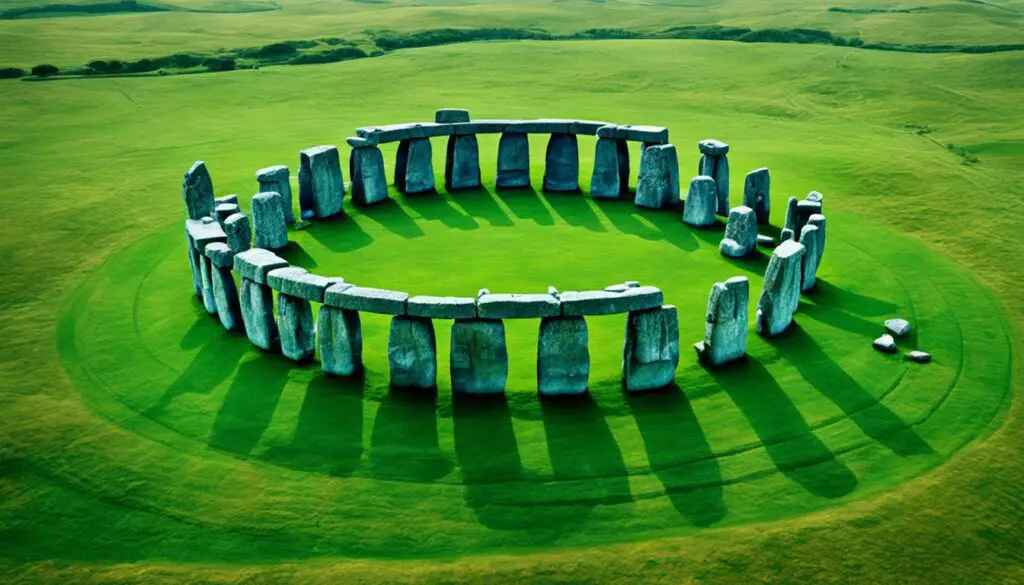
In recent years, Stonehenge and its surrounding area have witnessed a wave of exciting discoveries thanks to the implementation of advanced archaeological techniques. Innovative methods such as ground-penetrating radar, aerial photography, and remote sensing have revolutionized our understanding of this ancient monument.
Ground-penetrating radar has allowed researchers to explore beneath the surface of the earth, revealing hidden features and structures that were previously unknown. This technique has proved invaluable in mapping the layout of Stonehenge and identifying potential areas of interest for further investigation.
Aerial photography has provided a unique perspective on Stonehenge, allowing experts to view the monument from above and uncover new details about its design and layout. This bird’s-eye view has offered fresh insights into the relationship between Stonehenge and its surrounding landscape.
Remote sensing techniques, such as LiDAR (Light Detection and Ranging), have been instrumental in detecting subtle variations in the terrain. By analyzing the reflected laser pulses, archaeologists have identified previously hidden archaeological features and gained a better understanding of Stonehenge’s purpose and construction.
The use of these cutting-edge techniques has resulted in a plethora of fascinating discoveries, shedding light on the enigmatic history of Stonehenge and challenging previous assumptions. From the identification of new structures and pathways to the detection of ancient settlements in the vicinity, each find brings us closer to unraveling the true significance of Stonehenge.
As research continues, we can expect further exciting breakthroughs and a deeper understanding of this extraordinary archaeological site. Stay tuned for the latest updates on Stonehenge discoveries and the ongoing excavation efforts.
New Insights into Stonehenge’s Purpose and Construction
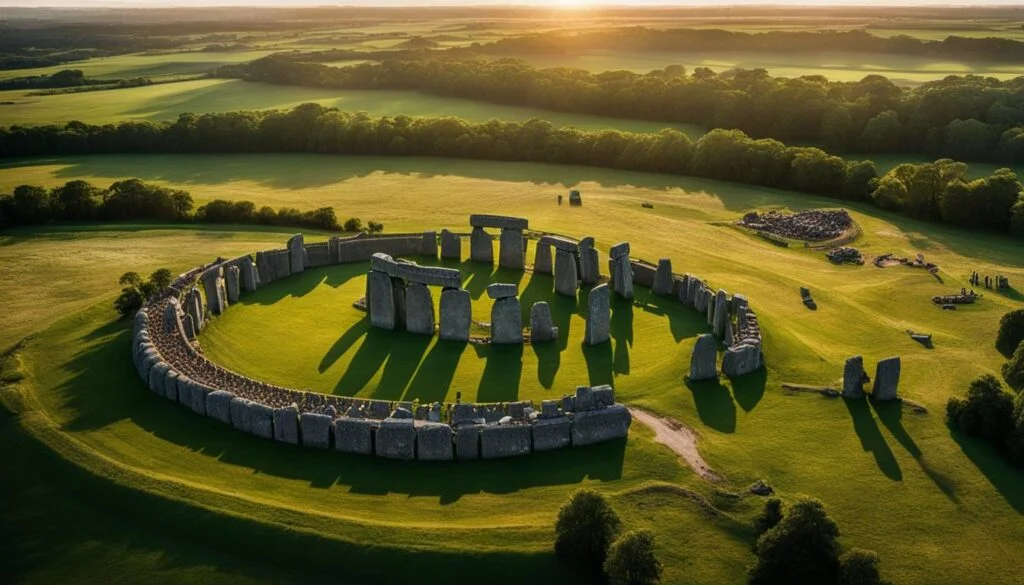
The recent excavations and surveys have provided fascinating new information about Stonehenge, shedding light on its purpose and construction. It is now evident that the builders of Stonehenge possessed exceptional craftsmanship skills, showcasing their expertise in various crafts. Furthermore, the discovery of an ancient village near Stonehenge has offered valuable insights into the lives of the individuals who built and utilized the monument.
These recent findings strongly suggest that the construction of Stonehenge was a highly coordinated and organized undertaking that required the involvement of a substantial workforce. The builders, with their mastery of different crafts, meticulously shaped and arranged the monumental stones, leaving an enduring legacy that continues to intrigue and captivate us today.
Conclusion
Stonehenge, with its fascinating history and cultural significance, continues to captivate researchers and visitors alike. While the direct connection between Stonehenge and Celtic mythology may not be as strong as previously believed, the monument’s enigmatic purpose and mysterious origins remain subjects of great intrigue.
Stonehenge serves as a testament to the ancient peoples who lived and worked in the area thousands of years ago. Its presence in the landscape and its architectural marvels stand as a testament to their advanced knowledge and craftsmanship.
As we continue to uncover the secrets of Stonehenge through ongoing research and advanced archaeological techniques, we deepen our understanding of its historical and spiritual significance. From its possible role as an astronomical observatory to its use as a burial site and center of ancestor worship, Stonehenge offers valuable insights into the beliefs, rituals, and lives of ancient civilizations.
While many questions remain unanswered, Stonehenge’s enduring legacy reminds us of the enduring power of human curiosity and the importance of preserving and studying our ancient heritage. It stands as a symbol of our connection to the past and the wonders that continue to unfold from our exploration of this remarkable ancient monument.
FAQ
What is the connection between Stonehenge and Celtic mythology?
While Stonehenge predates the arrival of the Celts in Britain, it is possible that the Celts incorporated Stonehenge into their religious and ceremonial practices.
How was Stonehenge constructed?
Stonehenge was built in several stages, starting with the creation of an earthwork enclosure and the construction of the Aubrey Holes. The large sarsen stones were then brought from Marlborough Downs and the smaller bluestones from the Preseli Hills in Wales.
Who were the people behind the construction of Stonehenge?
Recent research has shown that the builders of Stonehenge were part of a sophisticated society with advanced knowledge of various crafts.
What was Stonehenge’s purpose?
While it is commonly believed that Stonehenge served as an astronomical observatory, its purpose may have been broader, possibly having spiritual or ceremonial significance.
Was Stonehenge used as a burial site?
The discovery of human remains at Stonehenge and nearby monuments suggests that it was indeed used for burial and ancestor worship throughout its history.
Did the Celts have any influence on Stonehenge?
Although the Celts arrived in Britain long after Stonehenge was constructed, they may have recognized the site’s spiritual significance and incorporated it into their rituals and mythology.
What recent discoveries have been made at Stonehenge?
Advances in archaeological techniques have led to new insights into the purpose and construction of Stonehenge, providing a deeper understanding of the people who built and used the monument.
What is known about Stonehenge’s purpose and construction?
Recent excavations and surveys have revealed that the builders of Stonehenge were skilled in various crafts, and the discovery of an ancient village near the monument has provided further insights into their lives.
How does Stonehenge fit into Celtic mythology?
Though the direct connection between Stonehenge and Celtic mythology may not be as strong as once believed, the mysterious origins and enigmatic purpose of the monument continue to captivate researchers.
What is the cultural significance of Stonehenge?
Stonehenge holds an important place in the cultural history of the region, representing a fascinating ancient monument that offers insights into the people who lived and worked in the area thousands of years ago.


